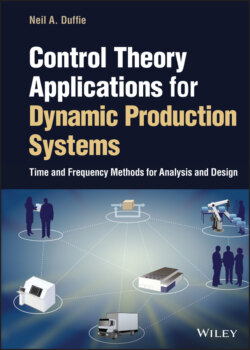Читать книгу Control Theory Applications for Dynamic Production Systems - Neil A. Duffie - Страница 21
Example 2.3 Continuous-Time Model of Mixture Temperature Regulation using a Heater
ОглавлениеExperimental results can be used to obtain component models. Consider a portion of a production process in which it is necessary to deliver a mixture at a desired temperature. A heater at the outlet of a pipe is used to raise the temperature of the mixture flowing in the pipe to the desired level. Predicting the heater voltage required to deliver the mixture at the correct temperature is unlikely to be successful because of uncertainty in mixture inlet temperature. Therefore, as shown in Figure 2.4, a closed-loop temperature regulation approach is used in which a temperature sensor is placed at the end of the pipe and feedback from this sensor is used to adjust the heater voltage until the desired mixture temperature is obtained.
Figure 2.4 Mixture outlet temperature regulation in which a heater is used to raise the temperature of a mixture to a desired temperature.
The experimental results in Figure 2.5 show how the temperature of the mixture at the outlet of the pipe changes as a function of heater voltage and time. The temperature of the mixture at the inlet of the pipe is assumed to be constant throughout the test: hi(t) = hi(0) °C for all t seconds. Initially, the heater voltage has been v(t) = 0 V for a long enough time to ensure that the temperature of the mixture at the outlet of the pipe ho(t) °C is the same as the temperature of the mixture at the inlet: ho(0) = hi(0) °C. A constant heater voltage v(t) = 50 V is applied for time 0 ≤ t seconds, and the temperature of the mixture at the outlet of the pipe is measured for the period of 400 seconds. The change in temperature3 of the mixture Δh(t) °C then is calculated where
Figure 2.5 Experimental results obtained by applying a constant heater voltage v(t) = 50 V starting at time t = 0 seconds and measuring the outlet temperature ho(t) °C when the inlet temperature is constant hi(t) = 60°C.
The temperature of the mixture changes relatively rapidly at the beginning of the experiment as shown Figure 2.5, but has reached a final value at the end of the experiment. This behavior can be characterized by the relationship
where time constant τ seconds characterizes how quickly temperature difference Δh(t) °C changes in response to heater voltage v(t) V and constant of proportionality Kh °C/V relates the final temperature difference to the applied heater voltage; Kh can be referred to as the mixture heating parameter.
The known solution of this differential equation for constant input v(t) = v(0) V and initial condition Δh(t) = 0 is
and when t = τ seconds,
The estimated time constant τ = 49.8 seconds therefore can be obtained by noting the time in Figure 2.5 when approximately 63% of the final change in temperature is reached.
The estimate of the value of mixture heating parameter Kh can be obtained from the ratio of the constant final change in temperature in Figure 2.5 to the constant voltage applied to the heater: Kh = 20/50 = 0.4°C/V. The model of mixture heating then is approximately
One option for the decision rule used in the mixture temperature regulation component is
where hc(t) °C is the desired temperature of the mixture at the outlet of the pipe and Kc (V/second)/°C is a voltage adjustment decision parameter. This decision rule causes the heater voltage to continually change until ho(t) = hc(t) °C. Choosing a relatively large value of Kc causes heater voltage and outlet temperature to change more quickly but tends to require higher heater voltages and can result in oscillatory outlet temperature behavior. Choosing a relatively small value of Kc causes the heater voltage to change less quickly and when the inlet temperature of the mixture fluctuates, longer-lasting deviations in outlet temperature can result. The analysis and design methods described in subsequent chapters facilitate selection of a value for temperature regulation parameter Kc and assessment of the appropriateness of this decision rule.
